Welcome to our comprehensive guide on understanding the different types of fertilizers for houseplants. Whether you’re a seasoned plant parent or just starting out, this article will equip you with the knowledge to nourish your green companions effectively.
About Fertilizer
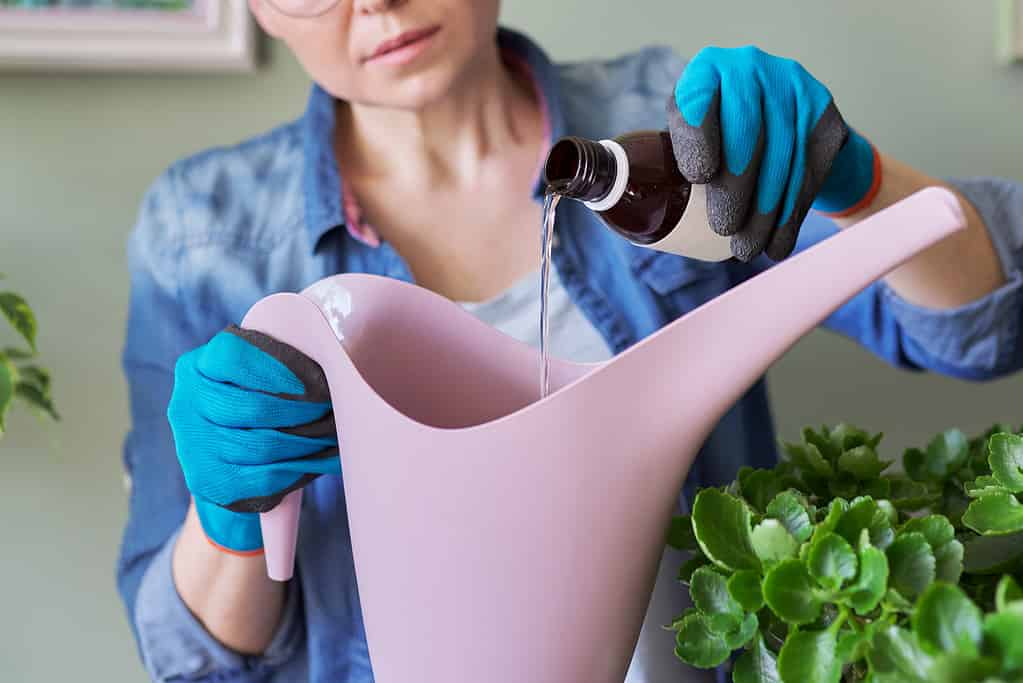
Mix liquid fertilizer with water and use it when it is time to water your houseplants.
©Valeriy_G/iStock via Getty Images
Fertilizer is a plant nutrient source that helps your plants to grow and stay healthy. Fertilizers contain essential nutrients such as nitrogen, phosphorus, and potassium (NPK) in various forms. These nutrients are vital for the health of houseplants, but they may not be readily available from the soil or water sources you use. Applying fertilizer regularly can help your plants thrive and provide them with the nourishment they need to remain strong and vibrant.
The right type of fertilizer can also help to increase the growth rate of your plants and promote flowering. In addition, fertilizer can help your plants to resist disease and pests. It’s important to note that not all fertilizers are created equal. Select a fertilizer appropriate for your houseplants if you want healthy and robust growth.
Types of Fertilizer
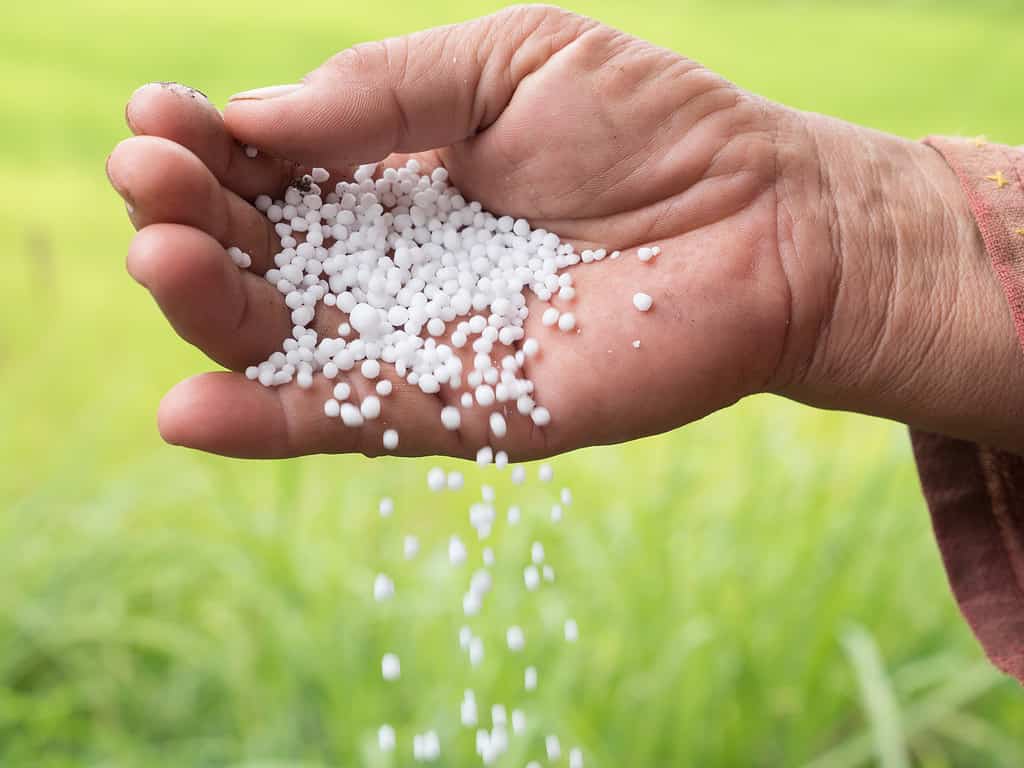
Synthetic, granular fertilizers (like above) mix in with the soil when you repot your houseplant.
©Singkham/iStock via Getty Images
Water-soluble fertilizers: These are readily available in liquid or powder form and are easily absorbed by plants when mixed with water. They typically contain a balanced ratio of NPK, plus additional trace elements such as magnesium and iron.
Slow-release fertilizers: A slow-release fertilizer releases nutrients slowly over time, so it is ideal for houseplants that do not require regular feeding due to their low nutrient requirements. This type of fertilizer will last longer than water-soluble fertilizers and is available in both organic and synthetic forms.
Granular fertilizer: a granular fertilizer comes in both pellets and spikes. You can apply them to houseplants by manually mixing them into the potting soil. Though cost-effective, this type of fertilizer does not offer good control of the amount of nutrients it deposits when the pot is watered. Therefore, it is not ideal for feeding houseplants.
Organic fertilizers: These are derived from natural sources such as manure, compost, seaweed extracts, and fish emulsion. They add essential nutrients to the soil while also improving its structure and increasing its microbial activity.
Foliar sprays: Foliar sprays contain a concentrated solution of fertilizer. You can use these to directly feed houseplants by spraying their leaves. This type of fertilizer is especially useful for plants that do not have access to soil nutrients, such as air plants or terrariums.
What are Houseplant Fertilizer Ingredients?
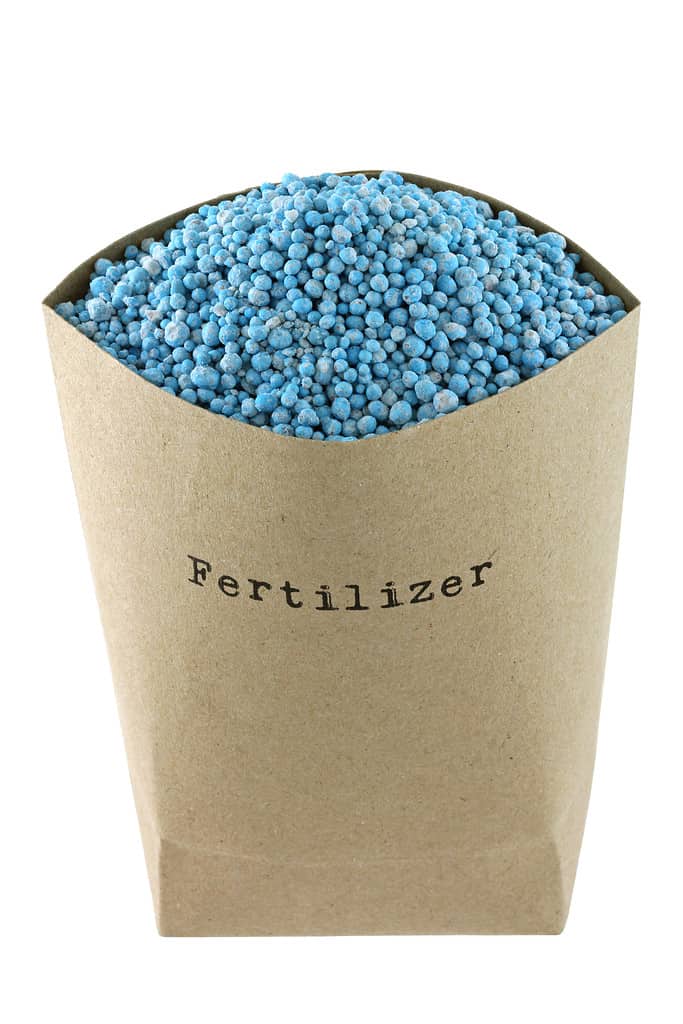
NPK stands for nitrogen, phosphorus, and potassium. These are the main macronutrients that plants need.
©sasimoto/Shutterstock.com
The primary ingredients in houseplant fertilizers are nitrogen, phosphorus, and potassium. These macronutrients provide essential nutrients for healthy plant growth. Nitrogen helps plants to produce more green foliage while phosphorus encourages root growth and flowering. Potassium is important for building strong cell walls and helping the plant to take up water from the soil more efficiently.
The micronutrients found in some fertilizer mixtures include calcium, magnesium, sulfur, iron, zinc, manganese, copper, and boron. Micronutrients are essential for a variety of functions in plants, including photosynthesis, respiration, and metabolism. They also help to strengthen cell walls and promote blooming.
It’s important to note that there are different types of fertilizer for different types of plants and their needs. For example, some fertilizers are better for flowering or fruiting plants while others may be more suitable for foliage growth. When selecting a fertilizer, always read the label carefully to ensure it contains the right type and amount of nutrients your particular houseplant requires.
When to Feed Your Houseplants
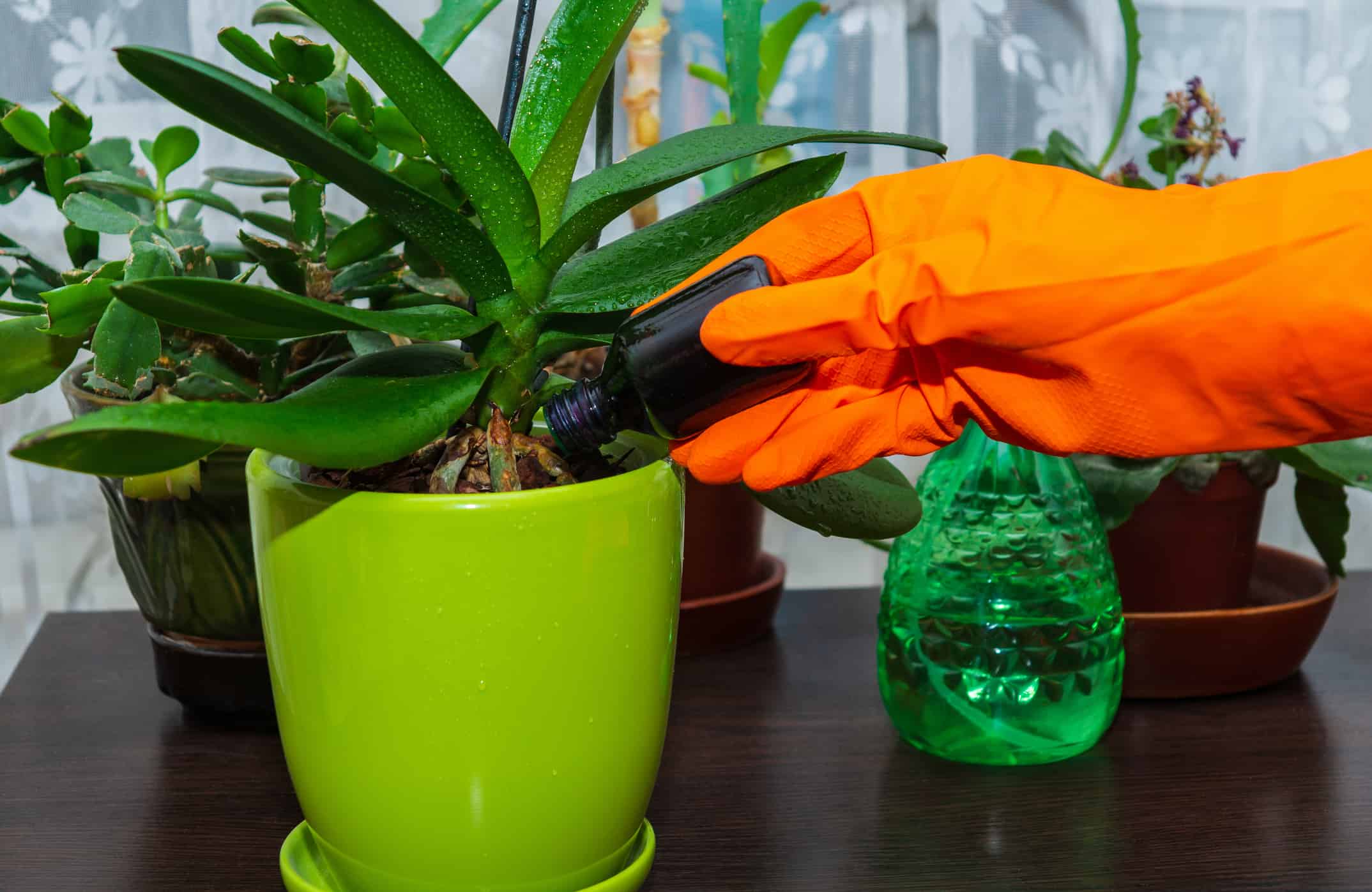
Just like outdoor plants, houseplants start growing fresh new leaves in the spring. This is the time to feed.
©iStock.com/VITALII BORKOVSKYI
You should fertilize your houseplants during the growing season, which is typically in the spring and summer. During this time, plants will benefit from regular applications of fertilizer to ensure they have access to all the vital nutrients they need for healthy growth. However, it is important not to over-fertilize as too much can damage or even kill your houseplants.
Spring
Around 2 months before the last spring frost is expected, start fertilizing houseplants. For example, in many northern US States, mid-March is when the days start to get longer and houseplants begin to become active again. If you don’t want to hassle with frost dates, just wait until the houseplant has its first new growth in the spring. Mix the first two batches of fertilizer at half the recommended strength. This is to provide the plants with just enough nutrients to support their development without overfeeding them.
Summer
At the beginning of June, you can start a regular fertilizer schedule. Base this schedule on the type of fertilizer that you choose. If you have a liquid fertilizer, you can apply this every time you water the plant. If you have a granular product, you will apply this with every other watering. Add the slow-release type fertilizers to the soil when you repot your plant into new containers.
Fall
Stop fertilizing your houseplants at the end of August. You will probably need to reduce watering at this time also. The days are getting shorter, and many houseplants are getting ready for a winter dormancy period.
Winter
Do not fertilize your houseplants at all during the winter. They are not actively growing, and excess fertilizer will build up in the soil, causing burns to the roots. You can see signs of fertilizer burn as brown leaf tips. If you live in a tropical climate and have no winter season this rule does not apply to you.
Finally, be sure to monitor your plants regularly for signs of nutrient deficiencies or excesses so that you can make adjustments to your fertilizing regimen as necessary. Regular monitoring will allow you to ensure that your houseplants get exactly what they need for healthy growth!
Which Type of Houseplant Fertilizer is Best?
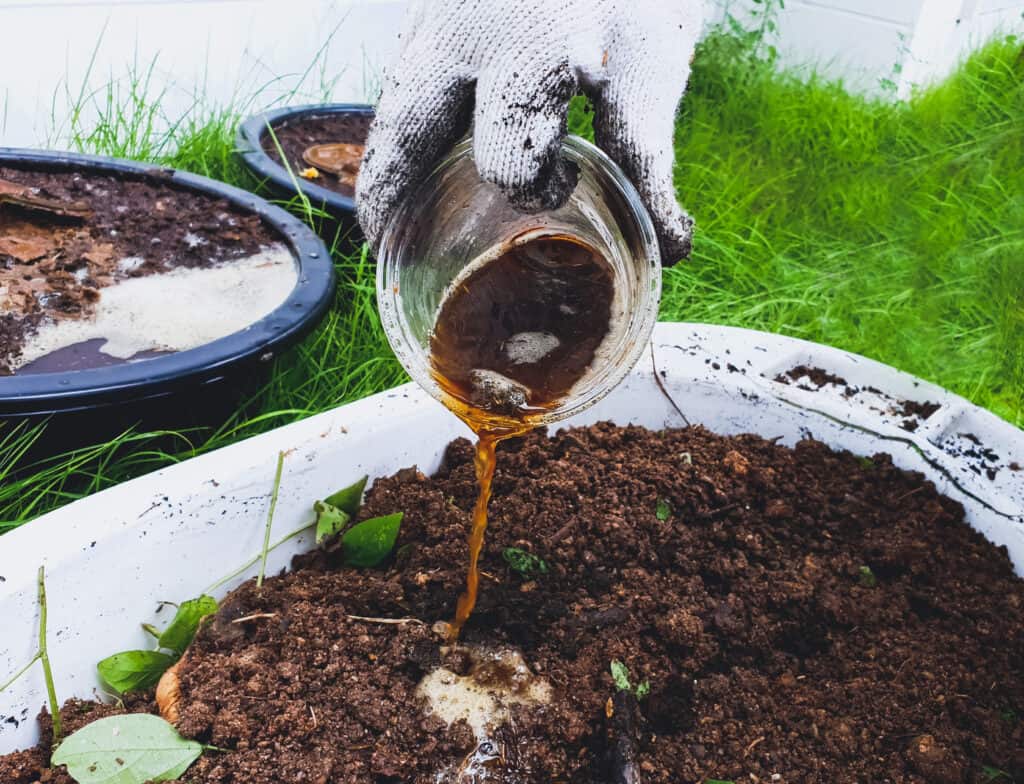
If you dilute liquid fertilizers by half, you can add them directly to the soil.
©The little paint/Shutterstock.com
This is entirely up to you. Some people believe that organic fertilizers made from worm castings, seaweed, or compost are better for the houseplant. Others like synthetic fertilizers because they are easy to use and cost-effective.
It can be hard to know which type of fertilizer to use for houseplants. We suggest that when selecting a product, it should state on the packaging that it is specifically for houseplants, and if possible, purchase an organic option. This is because outdoor plants and houseplants require different ratios of nutrients and minerals, and organic fertilizers are healthier for the soil and the planet. Organic fertilizers are made from natural sources, while synthetic fertilizers are created from compounds produced by the petroleum industry. Organic fertilizers not only provide nutrients but also help restore nutrient-depleted soil and introduce beneficial microbes into the soil over time.
What Are the Signs of Too Much Plant Food?

Keep a bucket of granular or slow-release fertilizer handy for when you replant your houseplants into larger containers.
©VH-studio/Shutterstock.com
You may have given your houseplant fertilizer once or twice, but you need to be careful not to overdo it. Too much of a good thing can be bad for plants and can end up killing them. If you’ve been overfertilizing for a few months, you may start to see signs of too much fertilizer, such as yellow or brown leaves. Overfertilizing can block your plant from getting the nutrients it needs, which will eventually lead to its death. Therefore, it’s important to be aware of how much fertilizer you use and not give your plant too much. It is a good idea to know which of your houseplants are heavy feeders and which are not. Reference the chart below for specific requirements for each type of houseplant.
A Chart of Houseplant Fertilizer Requirements
| Houseplant | When to Fertilize | Which Fertilizer to Use |
|---|---|---|
| Calathea | Once per month in spring, summer, and fall | 10-10-5 |
| Maranta | Every 30 days in spring, summer, and fall | 10-10-5 |
| Stromanthe | Once per month in spring, summer, and fall | 10-10-5 |
| Anthurium | Once per year in the summer | 10-10-10 |
| Spathiphyllum | Once per month in spring, summer, and fall | 10-10-10 |
| Zamioculcas | Once each season, spring, summer, and fall. No more than 3 times per year. | 10-10-10 |
| Pachira | Every 2 weeks in spring, summer, and fall | 10-10-10 |
| Oxalis | All year, every 30 days | 10-10-10 |
| Peperomia | Once each season, spring, summer, and fall. No more than 3 times per year. | 10-10-10 |
| Ficus | Every 30 days in spring, summer, and fall | 10-10-10 |
| Cissus | Every 21 days all year | 10-10-10 |
| Strelitzia | Every 30 days in spring, summer, and fall | 10-10-10 |
| Alocasia | Every 14 days in spring, summer, and fall | 20-20-10 |
| Aglaonema | Every 30 days in spring and summer | 20-20-20 |
| Dieffenbachia | Every 14 days in spring and summer. Once in the fall | 20-20-20 |
| Philodendron | Every 30 days in spring, summer, and fall | 20-20-20 |
| Syngonium | Every 14 days in spring, summer, and fall. One time in the winter | 20-20-20 |
| Epipremnum | Every 14 days in spring, summer, and fall. One time in the winter | 20-20-20 |
| Monstera | Every 14 days in spring, summer, and fall. One time in the winter | 20-20-20 |
| Begonia | Every 21 days all year | 10-20-10 |
| Cyclamen | Every 14 days all year | 10-20-10 |
| Tillandsia | Every 30 days in spring and summer only | 17-8-22 |
| Cacti | Once in spring, once in summer | 2-2-2 |
| Succulents | Once in spring, once in summer | 2-2-2 |
The photo featured at the top of this post is © Mallmo/Shutterstock.com
Thank you for reading! Have some feedback for us? Contact the AZ Animals editorial team.







